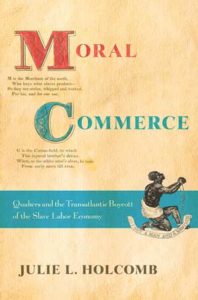Moral Commerce: Quakers and the Transatlantic Boycott of the Slave Labor Economy
Reviewed by Larry Ingle
August 1, 2017
 By Julie L. Holcomb. Cornell University Press, 2016. 252 pages. $39.95/hardcover or eBook.
By Julie L. Holcomb. Cornell University Press, 2016. 252 pages. $39.95/hardcover or eBook.
Buy from QuakerBooks
Those who know much about Quaker history are aware of sharp differences among Friends, especially since the late eighteenth century, over theology, discipline, and centralization versus local autonomy. But Friends found unity against slavery fairly early, scattered in the 1680s, increasing in the next century, achieved by the 1770s; by that time, those who refused to free any slaves they possessed were disowned.
They were not, however, uniform about tactics. Most were willing to stand aside from the “peculiar” institution, content to witness silently against something they regarded as worthy only of reproach. Others like John Woolman, who died just before his yearly meeting made slave owning a disownable offense, worked tirelessly among Quakers to persuade fellow believers to free their slaves. Quakers affixed their names to petitions against the inhumane practice. Lucretia Mott, a stalwart of many reforms, worked with non-Friends to organize against holding humans in bondage. Philadelphian Anthony Benezet and New Yorker Elias Hicks wrote books against the evil institution, the latter, like Woolman and Mott, insisting that people refrain from using goods produced by slave labor. Newspaper editor Benjamin Lundy pioneered in aiming newsprint at it. Indiana Yearly Meeting even split when a faction divided from the main, more conservative, body and insisted that Friends support the Liberty Party and cease purchasing slave-produced goods. Differences on means thus shattered unity on ends.
Julie Holcomb’s well-done book shows the difficulty that Friends and free blacks had in being faithful to the relatively simple testimony that they should boycott materials like cotton and sugar or goods made from such products. For one thing, even leading abolitionists like William Lloyd Garrison, who had once supported the boycott, decided that it was simply too difficult to find freely made products in a complex economy. Only for brief periods in the 1790s and 1820s in England did boycotters win over a lot of support and influence people to shun slave-produced sugar.
Free produce was scarce and hence more expensive, exacting high costs on those committed to conscientious opposition of slavery. Free stores were established, but few lasted long, given these factors. Proclaiming that using economic methods against slavery would undermine the institution by hitting slave-owners’ pocketbooks might appeal in theory, but acting on such arguments depleted one’s own purse rather quickly. This fact certainly helps explain why in 1847 one periodical estimated that only 10,000 Friends or about one-tenth of the total in the United States boycotted slave goods.
Holcomb does make clear that the boycott movement enhanced Quaker women as the “moral core” of the abolitionist movement in nineteenth-century America, because they were the typical purchasers of the problematic goods. And it also connected some Quakers to the much smaller free black community that had its own reasons of solidarity for choosing free goods.
Ironically, Woolman, and to a lesser extent Hicks, proved the most prescient. Boycotting slave goods, as one abolitionist phrased it, was little more than “bailing out the Atlantic with a spoon.” The same Northerners asked to refrain from buying cotton and sugar were the ones producing clothes, shoes, and hoes for enslaved blacks in the South. Woolman and Hicks targeted not only cotton and sugar, but they also raised fundamental questions about the very nature of the market economy of which slavery was such an integral part. So Woolman’s freely produced un-dyed linen clothing made him “singular,” an eighteenth-century word for unique; he thus stood out, true, but by definition, was not necessarily influential. So it took a civil war to end slavery, presenting Friends with yet another dilemma.



Comments on Friendsjournal.org may be used in the Forum of the print magazine and may be edited for length and clarity.